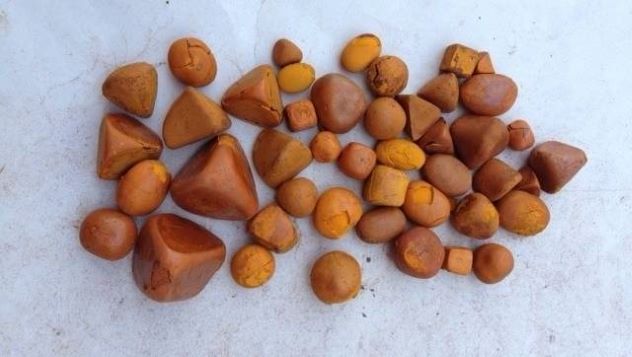 Our World
Our World  Our World
Our World  Pop Culture
Pop Culture 10 Incredible Female Comic Book Artists
 Crime
Crime 10 Terrifying Serial Killers from Centuries Ago
 Technology
Technology 10 Hilariously Over-Engineered Solutions to Simple Problems
 Miscellaneous
Miscellaneous 10 Ironic News Stories Straight out of an Alanis Morissette Song
 Politics
Politics 10 Lesser-Known Far-Right Groups of the 21st Century
 History
History Ten Revealing Facts about Daily Domestic Life in the Old West
 Weird Stuff
Weird Stuff 10 Everyday Products Surprisingly Made by Inmates
 Movies and TV
Movies and TV 10 Actors Dragged out of Retirement for One Key Role
 Creepy
Creepy 10 Lesser-Known Shapeshifter Legends from Around the World
 Our World
Our World 10 Science Facts That Will Change How You Look at the World
 Pop Culture
Pop Culture 10 Incredible Female Comic Book Artists
 Crime
Crime 10 Terrifying Serial Killers from Centuries Ago
Who's Behind Listverse?

Jamie Frater
Head Editor
Jamie founded Listverse due to an insatiable desire to share fascinating, obscure, and bizarre facts. He has been a guest speaker on numerous national radio and television stations and is a five time published author.
More About Us Technology
Technology 10 Hilariously Over-Engineered Solutions to Simple Problems
 Miscellaneous
Miscellaneous 10 Ironic News Stories Straight out of an Alanis Morissette Song
 Politics
Politics 10 Lesser-Known Far-Right Groups of the 21st Century
 History
History Ten Revealing Facts about Daily Domestic Life in the Old West
 Weird Stuff
Weird Stuff 10 Everyday Products Surprisingly Made by Inmates
 Movies and TV
Movies and TV 10 Actors Dragged out of Retirement for One Key Role
 Creepy
Creepy 10 Lesser-Known Shapeshifter Legends from Around the World
10 Types of Jewelry You Might Think Twice about Wearing
The act of adorning the human body with various types of ornamentation pre-dates the written record. Whether in the form of pieces of shell and animal teeth, or a dazzling chunk of diamond rock, we humans have seemingly always found a way to appreciate the beauty of these natural gifts from nature. Let’s face it, who doesn’t like wearing a nice piece of bling?
But here are ten types of jewelry that even the most trend-conscious over-accessorizer might have some second thoughts about.
Related: 10 Fascinating Facts About Corpse Fashion
10 Human Hair
When my own grandmother passed away, we were tidying her belongings, and I came across a finely woven necklace. Apparently, it’s called “micro macrame” (yes, that’s a thing!). It was incredible and very intricate, a complicated and incredibly ornate combination of swirls, twists, and knots. It clearly took some artisan with better eyesight than mine a great number of hours to create. It turned out that it was made of human hair.
From the 1600s through to the Victoria era, memorial hair jewelry was common. It was a popular practice called mourning jewelry, with the hair of departed loved ones being incorporated into rings, brooches, and necklaces. Queen Victoria often wore a pendant containing a lock of hair from her beloved husband Prince Albert, following his death from typhoid in 1861. In turn, she gave pieces of jewelry made from her own hair as gifts. Many of these pieces were given to her children (of which she had nine) and grandchildren (all 42 of them).
It has been suggested that because hair does not decompose as readily as the rest of the human body, it is the perfect medium to represent eternal life and the legacy of the departed.[1]
9 Human Teeth
Along similar lines to jewelry made from human hair, although sounding a tad more like a macabre craft project by Ed Gein, jewelry from human teeth has been found in a Neolithic settlement, dating from some 9,000 years ago. Archaeologists in Turkey found human teeth that seem to have been used as jewelry in Çatalhöyük. The human molars found in Çatalhöyük were deliberately modified, with holes drilled to thread the teeth onto leather string or animal sinew.
Queen Victoria rates a mention here, too, as she was the proud owner of an enamel brooch where the tuft on the head of the thistle is, in fact, one of the baby teeth of one of her many children.
More recently, Melbourne jeweler designer Polly Van Der Glas released a jewelry collection featuring human teeth set in sterling silver. Apparently, she even offers a 10% discount on commissioned jewelry pieces if you provide the teeth.
A quick search of Esty finds over 790 listings for human teeth jewelry, so it’s still the ornamentation of choice for a great many people out there![2]
8 Breast Milk
Yes, you read that right—breast milk. If you thought Queen Vic’s hair locket and tooth brooch were odd, now you can get your breast milk incorporated into an extra special memento. The breast milk is first dehydrated then mixed with either an epoxy resin or covered with a clear glaze.
“What a wonderful way to preserve the ‘liquid gold’ that we are only able to make for a certain period of time,” reads one product description. “This can be passed down for generations, and what a fantastic gift to give to your child, the root of their survival.”
Another seller states, “Our breast milk jewelry items are the most beautiful way to commemorate your breastfeeding journey. Your breast milk is encapsulated within a resin stone, with the option to add hair and/or umbilical cord too!”
Oh, and if you’re the crafty type, DIY kits are also available.[3]
I wonder if my husband would like a breast milk and umbilical cord pair of cuff-links for Christmas?
7 Cremated Remains (Ashes)
I have to admit it, I think some of the jewelry options for the ashes of your dear departed loved one look pretty cool.
Ashes can be incorporated into jewelry in several ways. The most basic is carrying a small portion of ashes in a miniature urn, hopefully, one with a snug-fitting lid. Another option is adding the ashes to glass in order to form beads or a focal pendant piece. Glass is a highly versatile medium that can produce a vast array of colors, finishes, shapes, and textures, so adding ashes to the mix is relatively straightforward (unlike dehydrating your breast milk!).
While less than a teaspoon of ashes is needed for inclusion in a bespoke piece of glass, more like 100–200 grams (¼–½ pound) of ashes or two to eight grams (up to ¼ ounce) of hair is required to make a memorial diamond. The ashes or hair have the carbon removed and purified, then a long process using high pressure and heat above 2,000°C (3,632°F) creates the diamond “seed.” Crystallization starts to occur around the carbon seed, and over time, a rough diamond is formed. This is then checked for quality and clarity, then faceted and polished, very much like you would a naturally formed gem.
Lab-made cremation diamonds are aesthetically very close in quality to mined diamonds, with essentially the same brilliance, shine, and durability. However, while natural diamonds must be mined, the creation of cremation diamonds poses no real threat of harm to our environment, nor does it involve the exploitation of poorer nations.
More recently, people are becoming increasingly concerned about the ethics of purchasing blood diamonds or conflict diamonds. These gems originate from areas controlled by forces or factions as opposed to legitimate and internationally recognized governments. Often diamond sales are used to fund military action against legitimate governments or in contravention of the fundamental human rights of Indigenous inhabitants.[4]
The popularity of diamonds is largely due to a successful and sustained marketing campaign, so this may become a viable alternative.
6 An IUD
For those who aren’t into TWA’s (Three Word Abbreviations), an IUD is an Intrauterine Device. It is a long-acting reversible form of contraception that is placed inside the uterus to prevent pregnancy.
FYI (another TWA), it is one of the more reliable forms of contraception, being more than 99% effective.
Melbourne, Australia-based jewelry designer Jacqui creates bespoke pieces from the likes of hair, teeth, and even bone to memorialize the dead and departed. However, Jacqui’s most unusual request by far was to make a necklace out of the plastic of a used IUD—yes, that intrauterine device inserted into women for contraceptive purposes.
“I declined that job due to plastic being difficult to sanitize, and I couldn’t guarantee the longevity of the piece,” Jacqui later explained. So technically, this was a creepy item NOT made into jewelry in this instance, but I’ll just assume that the customer found a more obliging artisan elsewhere. You can, however, find replicas on Etsy.[5]
5 Live Insects
Yes, those uber-trendy Victorians are at it again, creating an era when it was not unthinkable to go out and about, adorned by a living creepy-crawly or two.
Some theorize that this macabre craze was a response to a growing concern for the environment. In a world where the Industrial Revolution was a relatively recent development, middle-class women felt they were perhaps losing touch with Mother Nature. Charles Darwin’s controversial work on evolution, Origin of Species, was also published in 1859, spawning a seemingly insatiable interest in natural history.
Their solution, therefore, was to wear some of God’s own creatures by way of tribute.
One young Englishwoman of the time marveled that when traveling in Brazil, she observed: “the mountain was very rich in insect life, with the most brilliantly colored butterflies and beetles, large and small, including the green variety that I had only seen before set in brooches, earrings, rings, or tie-pins.” In a twisted irony, the demand for insect jewelry quickly pushed the most beautiful species to the brink of total extinction.
The practice evolved from jewelry merely incorporating insect parts and the occasional taxidermied hummingbird to further extremes, placing live insects in delicate cages, which would then be attached to a woman’s clothing with a pin. Some larger beetles would actually be encrusted with real gems and then attached to the wearer’s clothing with a fine chain.
Even today, in the Yucatan area in Mexico, large colorful makech beetles are covered in rhinestones and other bling and fixed with a gold chain and pin that essentially serves as a leash. The practice is said to have originated from an ancient Mayan legend, where a shaman took pity on a broken-hearted princess whose forbidden lover was sentenced to death. He magically turned the unfortunate young man into a sparkling, shiny beetle so she could still have him near for all eternity.[6]
4 Uranium
Why am I now just learning about uranium glass? But in my defense, I live in a nuclear-free country.
Uranium was once commonly incorporated into glass before melting and shaping to provide coloration and fluorescence in decorative glass. Proportions vary from mix to mix, but some pieces have been found to contain as much as 25% uranium oxide. It is sometimes called Vaseline glass or canary glass due to its yellowish color, and while under a UV blacklight, it emits an eerie green glow.
Before the health effects of radioactive material were fully understood, glass containing uranium was used to fabricate tableware and serving ware, as well as for jewelry. Some antique cloisonné jewelry also gets some of its lighter colors from small amounts of uranium used in the glaze.
The bulk of uranium glass jewelry is only negligibly radioactive. It would hardly register on even the most sensitive Geiger counter and is considered to be harmless. However, you can understand why many people would have some reservations about placing such an object on their body for any length of time.[7]
3 Roadkill
When Montana-based jewelry designer and long-time vegetarian April Hale accidentally hit a squirrel with her car, she wanted to take responsibility for the death instead of driving away. Hale called a friend to help her—surprisingly—cook and eat the critter. “It all comes down to environmental responsibility, and we need to start doing more of it,” Hale said. “I wanted to thank the squirrel. I wanted to act reverently toward it. I wanted to say that it was more than just an accidental death—it was going to nourish me. I was taking responsibility for my actions and making sure to reuse what I had used.”
Hale had been incorporating found animal fur in her work before the unfortunate squirrel incident, but she admits that she initially was afraid to even touch roadkill. Having overcome her fear, she now collects dead animals, which she skins, cleans, and fashions into jewelry.
“When you choose to adorn yourself with something, you acknowledge that it is a beautiful representation of yourself or what you stand for,” Hale said. “How wonderful is it when you know it is something that comes from this very earth? It connects us to the very ground we stand on and the surrounding animals. Because we breathe the same air, and we are all really made out of the same stuff.”
Similarly, London-based bespoke jewelry designer Kat Arnold says she found her “true calling” when, despite being a committed vegan, she stumbled across a puppy’s skull on a beach in Cuba. “I suddenly became really interested in the skull, and I didn’t want to put it back. I took it home to the UK in my suitcase, and because it was covered in dirt and dead bugs, I taught myself how to clean it by Googling it.” After cleaning the skull, she found herself “bonding with the bones.”
As a vegan, she is unwilling to use bones from animals that have been killed for human consumption. Instead, she sources animal bones—usually rabbits, crows, magpies, wild Spanish cats and dogs, snakes, badgers, squirrels, and owls—and other organic material from the side of motorways, from woods, collectors, and even from the local town government. Kat explains that her work transforms “natural waste” into “timeless treasures.”
Like April, Kat also realizes that many people would be unwilling to wear her unique creations. “I don’t think society has accepted that it’s okay to wear bones as jewelry just yet,” she admitted, but added, “Some people will see my jewelry and react with shock or disgust, but then they’ll have no problem wearing leather shoes.”[8]
2 Contact Lenses
Contact lens jewelry is actually a thing! People who are bored with unadorned eyeballs now have the option of blinging them up.
Dutch artist and designer Eric Klarenbeek has combined contact lenses with a string of tiny crystals and diamonds that dangle like suspended tears from your irises. The perfect accessory for the Insta crowd!
Klarenbeek explains that a “contact lens becomes jewelry, such as spectacles ever became a representation of our identity. Our fear for imperfectness makes us modify our surroundings and being, striving for virtual perfection. Not being someone we should be, but someone we could be. Aesthetics are more and more based on Photoshop’s capabilities and slightly becomes the norm for plastic surgery instead of nature. Eye jewelry shows our scientific capabilities while showing the beauty of imperfection.”
When asked what would happen if someone were to yank on the line, Klarenbeek responded, “It just falls out, or in the worst case, the wire might break.” Hopefully, it doesn’t take your eyeball with it!
Meanwhile, in India, there’s another form of eyeball bling on offer at Dr. Chawan’s Shekhar Eye Research Center. There they have been marketing contact lenses with a ring of diamonds in them, making the eyeball truly the newest frontier for accessorizing. Apparently, he was inspired by jewels embedded in his wife’s teeth, in case you were wondering![9]
1 Gallstones

Gallstones are hardened deposits of the digestive fluid in the gallbladder, a small organ located under the liver. Gallstones can vary in size and number and may or may not cause any kind of symptoms. People who do experience symptoms usually require gallbladder removal surgery. The experience of getting the gallstones removed is rather unpleasant and not to mention often expensive, but most folks simply don’t care about what happens to the gallstones that have been taken out. However, some people have found a creative way of using gallstones by making gallstone jewelry. As the saying goes, waste not, want not!
According to Hindu Business Online, a hospital team operated on a patient, removing an astounding 300 or so stones from a woman’s gall bladder. A staff member then designed a matching necklace, earrings, nose ring, and bracelet made from the gallstones.
In Punxsutawney, PA, a bead store owner posted of his experience when “A lady walked up to the counter with a ziplock baggie full of brownish-colored beads about a half-inch in diameter. They were irregular in shape and had no holes for stringing.” Upon being released from the hospital, the doctor handed her the bag of her recently removed gallstones. The store owner was asked to drill holes in each stone then create a necklace, stringing the “beads” together. He commented that even though they felt like hard clay, they were still delicate. He added that “the smell during the drilling process was less than desirable.”
Nicole Angemi posted on Instagram a photo of a rosary made by a man out of his own gallstones. She described how “They were removed from his body five years ago, and he kept them and made the rosary as a reminder that bad things should be turned into good things! He used 53 gallstones and had to create six fake ones in order to complete it.” She added, “I LOVE this!!!”[10]
It takes all types, I guess.








